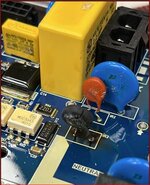userx2
Full Member level 3
Hello,
I have a design for US 120V operation with an NTC on the Live/Active line.
After being operational in the field for some 12 - 18 months, we are now getting many returns where this component has failed open circuit.
I was wondering what the cause of such a component going open circuit could be?
Are they sensitive to something?
There is no visible damage (has not blown up).
The component is EPCOS TDK B57235S0609M.
The loads on that line are a fridge compressor and a pressure pump. Both are triac controlled.
Since it takes such a long time to go faulty, I am not sure if there is something slowly wearing it out so to speak or a once in 18 months occurrence that causes the issue.
I am out of ideas at this stage and according to the calculations and the measurements we have done, the circuit is operating under the limits of NTC component.
All ideas and input will be greatly appreciated.
I have a design for US 120V operation with an NTC on the Live/Active line.
After being operational in the field for some 12 - 18 months, we are now getting many returns where this component has failed open circuit.
I was wondering what the cause of such a component going open circuit could be?
Are they sensitive to something?
There is no visible damage (has not blown up).
The component is EPCOS TDK B57235S0609M.
The loads on that line are a fridge compressor and a pressure pump. Both are triac controlled.
Since it takes such a long time to go faulty, I am not sure if there is something slowly wearing it out so to speak or a once in 18 months occurrence that causes the issue.
I am out of ideas at this stage and according to the calculations and the measurements we have done, the circuit is operating under the limits of NTC component.
All ideas and input will be greatly appreciated.
